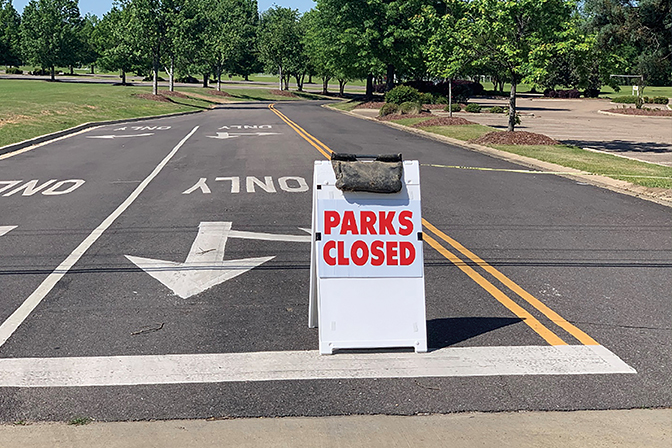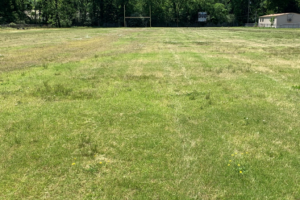CURRENT NEWS

Athletic Fields in these COVID Times
The COVID19 crisis has had a profound effect on many athletic fields in Mississippi and throughout the southeast. When the lockdowns and social distancing began, high schools were getting into the heart of their softball and baseball seasons, and some were starting to prepare for spring football. Our park and recreation fields were coming out of dormancy. Hopefully most had gotten their spring preemergence herbicide treatments down, but I am sure that some had not. Over-seeded fields were just starting to really grow as the weather warmed a bit. Now on the first of May, we have many different situations out there. Some institutions didn’t miss a beat in their turf management routines, and their fields look like they could host a tournament tomorrow. On other fields, the gates were locked mid-March and they have not been maintained since. The question is how do we get the fields that were neglected ready for play?
Mowing
The timing of the initial onset of the crisis was somewhat fortuitous in that it came in a period when our temperatures were below normal with cool nights. This slowed the growth of bermudagrass. Unfortunately this has also been a good growth period for cool-season weeds that were in our fields, and this has been a very good year for Poa annua and other cool-season weeds. On many fields, these weeds have held back the bermudagrass, and as I write this, it may not even be fully greened-up; although it is getting close. These are very competitive weeds, but their lifecycle is winding down. It is too late to control them with herbicides. The best tool to control them is a mower. On many fields the bermudagrass is not over 1 inch high and the weeds are much higher, so in our first mowing we will mostly be mowing weeds. For that reason field managers may want to mow once or twice with a rotary mower and collect the clippings before getting out the reel mower. The vacuum action of a rotary deck may also suck up some of the senescent leaves from last year’s grass. Once you get out the reel mower, try to get to the intended mowing height as quickly as possible. Most of the places I have seen will not have a lot of scalping, the bermudagrass is not growing fast yet. If you have access to a turf sweeper it would be a very good time to use it.
Once we get to our intended cutting height, follow the 1/3 rule to determine when to mow, not a calendar-based schedule. If we are mowing at 1/2 inch, this means mow when the grass reaches 3/4 of an inch or if we are mowing at 1-inch mow when we hit 1.5 inches. This might be a time to contemplate moving your mowing height up a little with the uncertainty of the coming season. If your normal mowing height is 1/2 inch, consider 5/8 of an inch, or if your normal mowing height is 3/4 inch, consider 7/8 of an inch, or if you are at 1 inch, perhaps 1 1/4. These higher mowing heights might allow you save on some mowing but still have you near your usual height of cut. The increased mowing height may actually slow the growth of the grass a bit. Research done at the University of Wisconsin found that grass at greens-height grew 40% faster than grass at collar height, so it stands to reason that increasing our mowing heights could decrease our growth rates. You should not consider mowing heights over 1.5 inches for bermudagrass fields unless there is a scarcity of manpower and/or funds. As mowing heights creep above 1.5 inches, traffic tolerance decreases.
If budgets allow, this is an excellent time to apply plant growth regulators (PGRs). Applying a product like trinexapac-ethyl will reduce mowing by about 50% and make scalping less likely if a mowing is missed due to wetness or lack of manpower. The savings in mowing normally cover the cost of the PGRs.

Fertilizer
If you have not had a soil test for a couple of years, now is the time. If you have a current soil test follow the recommendation for lime, P, and K application. Fields that were walked away from in mid-March or the first of April probably had not been fertilized yet. Once we begin to mow, we should also commit to fertility. For fields that are being maintained following the 1/3 rule, 1/2 to 3/4 of a pound of N per 1000 ft² per month is recommended. This amount should be increased to 1 pound once the field starts to receive traffic. A fertilizer that is half quick release N and half controlled release N would be preferred. If a full-scale mowing program cannot be committed to then a full fertility program should not be started. If a field is only being mowed high every couple weeks, then only about 1/4 to 1/3 pound of N per 1000 ft² per month is recommended. This will give the bermudagrass a fighting chance to fend off weeds while not promoting too much growth.
Weed control
Hopefully most turf managers were able to get out their spring preemergence herbicide on time, which would have been prior to mid-March. Some fields may not have received these treatments, and it is not too late to apply them. You have missed the initial flush of crab and goosegrass germination, but that flush may have been delayed by competition from unmown cool season weeds. If there has been emergence of crabgrass, goosegrass, and other warm season weeds, then applying a postemergence herbicide while weeds are young is most effective. A tank-mix of pre- and post-emergence herbicide would be a very timely application.
If heavy weed pressure developed while the field was unmaintained, it is likely that a seedbank of winter weeds developed. With that in mind, a fall preemergence herbicide application will be very important. This application should be made as our soil temperatures fall below 70 ̊F.
Cultural Practices
Since there’s no scheduled play, this would be an excellent time for aerification, vertical mowing, and topdressing, if manpower and budget allow it. This is an excellent time for hollow tine aerification followed by vertical mowing to process the cores. This would also be an excellent time to apply lime, P and K if needed. Grading, fraze mowing, heavy topdressing, and smoothing of fields are not always possible during regular use. There’s no better time for such an invasive procedure as during a pandemic.
This is an opportunity to do many of the cultural practices that often are neglected because of busy schedules. Hopefully manpower and budgets will allow them happen.
By Barry Stewart Ph.D., Associate Professor, Mississippi State University